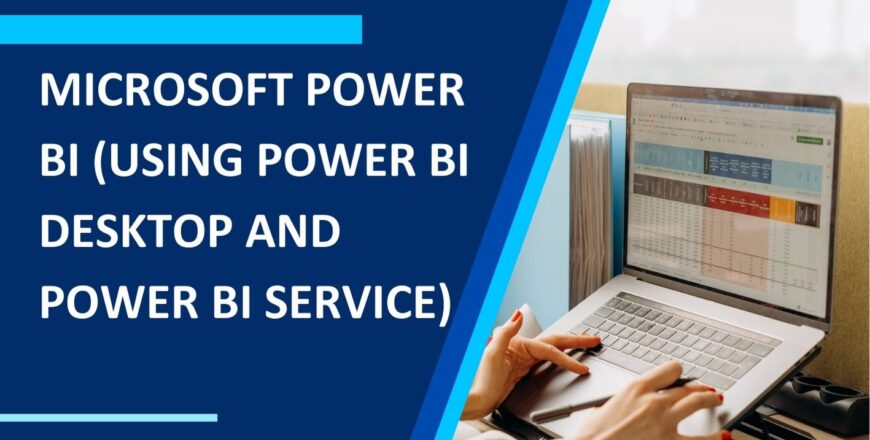
- Description
- Reviews
DURATION: 6 DAYS TRAINING / INSTRUCTOR-LED TRAINING
COURSE DETAILS
Power BI is a suite of business analytics tools that deliver insights throughout your organization. Connect to hundreds of data sources, simplify data prep, and drive ad hoc analysis. Produce beautiful reports, and then publish them for your organization to consume on the web and across mobile devices. Everyone can create personalized dashboards with a unique, 360-degree view of their business. In addition, scale across the enterprise, with governance and security built in.
PREREQUISITES
-
Microsoft Office Excel, Knowledge on Basic Database Management
TARGET AUDIENCE
-
Data Analyst, Sales, Human Resource, Admin Executives
OBJECTIVES
At the end of this course, the student must be capable of the following skillsets.
-
Connecting and shaping data using Query Editor
-
Creating a Data Model by connecting tables with BI relationship tools
-
Creating Filter Based Data Analysis Expressions
-
Use Advanced Data Analysis Expressions to get more insights from Datasets.
-
Create Dynamic Dashboards using Power BI Visuals
-
Add dynamic elements to report visuals that are user controlled.
-
Enhance reports and dashboards with artificial intelligence functionality.
-
Publishing Power BI Reports in Power BI Service
COURSE OUTLINE
MODULE 1: CONNECTING TO DATA USING POWER BI DESKTOP
-
Setting up Power BI Properties
-
The Power BI Interface and Workflow
-
Types of Data Connectors
-
The Query Editor Interface
-
Basic Table Transformations
MODULE 2: DATA SHAPING WITH QUERY EDITOR
- Text-Specific Tools
- Number-Specific Tools
-
Date-Specific Tools
- Index and Conditional Columns
- Grouping and Aggregating Data
- Merging Queries
- Appending Queries
- Appending Queries from a Folder
MODULE 3: QUERY EDITOR CONFIGURATIONS
- Data Source Settings
- Query Refresh Settings
- Additional Types and Categories
- Defining Hierarchies
- Column Quality and Profile
-
MODULE 4: CONNECTING TO EXTERNAL DATA SOURCES
- Getting Data from SharePoint
- Getting Data from Database
- Getting Data from the Web
- Power BI Data source Files
- Dynamic Source with Parameters
-
MODULE 5: INTRODUCTION TO DATA MODEL
- What is a Data Model?
- Database Normalization
- Data Tables vs Lookup Tables
- Relationship vs Merge Tables
-
MODULE 6: CREATING TABLE RELATIONSHIPS
- Star Schema
- Snowflakes Schema
- Managing and Editing Relationships
- Active vs Inactive Relationships
- Relationship Cardinality
- Connecting Multiple Tables
- Understanding Filter Flow
- Hiding Fields from Report View
MODULE 7: MEET DATA ANALYSIS EXPRESSIONS (DAX)
-
Introduction to Calculated Columns and Measures
-
Adding Columns and Measures
-
Implicit and Explicit Measures
-
Using Quick Measures
-
Filter Context Samples
-
Common DAX Functions and Categories
-
Basic Date and Time Functions
-
Basic Logical Functions
-
Text Functions
MODULE 8: APPLYING FILTER-BASED DATA ANALYSIS EXPRESSIONS
-
SWITCH Function
-
Joining Data with Related
-
CALCULATED Function
-
CALCULATE and ALL Function
-
CALCULATE and FILTER Function
-
Iterator X Functions
-
DAX Time Intelligence Formulas
-
Creating a Calendar Table
MODULE 9: ADVANCED DATA ANALYSIS EXPRESSIONS
-
Using Variables in DAX
-
Error Handling
-
Advanced Calculate Function
-
Keep Filters
-
Remove Filters
-
AverageX
-
RankX
-
Advanced Time Intelligence Function
MODULE 10: INTRODUCTION TO REPORTS AND DASHBOARDS
-
The Report View
-
Inserting Basic Charts and Visual
-
Formatting Options
-
Report Filtering Options
-
Matrix Visuals
-
Bar and Column Chart
-
Text and Date Slicers
-
Cards
-
Map Visuals
-
Line and Area Charts
-
Pie and Donut Chart
MODULE 11: PERFORM REPORT ANALYSIS
-
Explore statistical summary.
-
Use the Analyze feature.
-
Smart Narratives
-
Explore Q and A Visuals
-
Forecast and Trendlines
MODULE 12: POWER BI REPORTING TOOLS
-
Setting up Report Interaction
-
Adding Field and Number Parameter
-
Clustering
-
Grouping and Binning
-
AI Visuals
-
Bookmarks and Navigation Button
-
Creating Page Tooltips
-
Anomaly Detection
MODULE 13: ADDING DYNAMIC VISUAL TOOLS IN POWER BI REPORT
-
Adding Conditional Formatting
-
Editing Report Interactions
-
Adding Drill-through Filter
-
Preview: Custom Visual
-
Cards and KPI’s
-
Filled Map Visuals
-
Gauge Charts
-
Pause Visuals
MODULE 14: PUBLISHING AND SHARING
-
Publish from Power BI Desktop
-
Publish Reports to Web
-
Printing, PDFs and Exporting to PowerPoint
-
Export Data from a Visualization
-
Create a dashboard.
-
Understand real-time dashboards.
-
Enhance the dashboard usability.
MODULE 15: CREATE AND APPLY DASHBOARD SETTINGS
-
Create Dashboard in Power BI Service
-
Generate Quick Insights
-
Data Driven Alerts
-
Report Subscriptions
-
Data Lineage View
-
Data Lineage Tools
-
Create and Manage Workspaces
-
Publish Apps in Workspace
MODULE 16: CREATE AND MANAGE WORKSPACES
-
Create and manage a workspace.
-
Understand workspace collaboration.
-
Monitor usage and performance.
-
Distribute an App
MODULE 17: UNDERSTANDING DATA FLOWS
-
Quick tour at Dataflows Interface
-
Creating New Dataflows for Local file
-
Connecting to Dataflow to Power BI Desktop
-
Scheduled Refresh Dataflows
MODULE 18: REFRESHING DATASETS
-
Understanding Data Refresh
-
Personal Gateway
-
Replacing a Dataset
-
Troubleshoot gateway connectivity
-
Replacing a Dataset (Moving away, uploading new PowerBI Files)
MODULE 19: ROW-LEVEL SECURITY
-
Understand aspects of Power BI security
-
Configure static and dynamic row-level in Power BI Desktop
-
Configure static and dynamic row-level in Power BI Service
-
One dashboard with multiple accesses with respective RLS/views (multi-user dashboard)
MODULE 20: PYTHON INTEGRATION IN POWER BI
-
Python Integration in Power BI
-
Download & Connect Python to Power BI
-
Create Data with a Python Script
-
Import External Data with Python
-
Run a Python Script in Power Query
-
Create a Visual with Matplotlib
